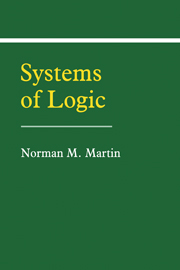Book contents
- Frontmatter
- Contents
- Preface
- 1 Formal Systems and Structure Theory
- 2 Zero-Order Logic: Proof Theory
- 3 Zero-Order Model Theory
- 4 Positive Implication
- 5 Negation
- 6 Complete Implication-Negation Logic
- 7 Disjunction
- 8 Conjunction
- 9 Multi-Connective Systems
- 10 Strict Implications: Introduction
- 11 Strict Implications: Additional Results
- 12 Quantification and First-Order Logic
- 13 Quantification and Complete Logics
- 14 Quantification and Incomplete Logics
- 15 Interpretation of Formal Systems
- Appendix: Historical and Bibliographical Remarks
- Subject Index
- Index of Systems
- Index of Symbols
2 - Zero-Order Logic: Proof Theory
Published online by Cambridge University Press: 12 March 2010
- Frontmatter
- Contents
- Preface
- 1 Formal Systems and Structure Theory
- 2 Zero-Order Logic: Proof Theory
- 3 Zero-Order Model Theory
- 4 Positive Implication
- 5 Negation
- 6 Complete Implication-Negation Logic
- 7 Disjunction
- 8 Conjunction
- 9 Multi-Connective Systems
- 10 Strict Implications: Introduction
- 11 Strict Implications: Additional Results
- 12 Quantification and First-Order Logic
- 13 Quantification and Complete Logics
- 14 Quantification and Incomplete Logics
- 15 Interpretation of Formal Systems
- Appendix: Historical and Bibliographical Remarks
- Subject Index
- Index of Systems
- Index of Symbols
Summary
Our next task is to formulate exactly the notion of a derivation of a wff A from a set of wffs α (in a calculus). The basic notion is that of a string or sequence of wffs each of which is an element of α or follows from earlier wffs by application of a rule of the calculus and whose last element is A. For suitable calculi, a minor revision of this condition would suffice to define derivation. But because we also want to allow systems that use subordinate derivations (sometimes called “natural deduction” systems), we will have to take a more complicated path. Perhaps the paradigm of the kind of rule we have to accommodate is “conditionalizcuion, ” which asserts that if we can derive B from a set of premises a together with an additional premise A, we can derive “if A, then B” from the premise set a. Intuitively, we have a sequence of derivations in the first sense, except that the rules must allow reference to earlier “derivations” in the sequence. Here the matter is complicated by the fact that, normally at least, it is not the details of the subordinate derivation, but what conclusion follows from what premises, which is the relevant information. However, the fact that the principal derivation has certain premises and conclusions unfortunately does not specify what wffs are allowed to be premises and conclusions in the subordinate derivations.
- Type
- Chapter
- Information
- Systems of Logic , pp. 16 - 37Publisher: Cambridge University PressPrint publication year: 1989



